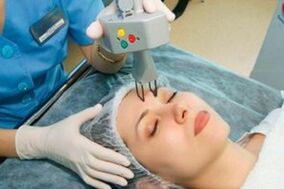
There are so many innovative techniques for preserving youth that patients sometimes get lost in their choices.
Those who want to activate the natural processes of skin renewal and rejuvenation can be offered such an effective procedure as fractional thermolysis, during which a laser grinder removes the upper layer of the epidermis.
Fractional laser skin rejuvenation is one of the more effective types of cosmetic procedures that can combat age-related skin changes.
The method has its own specific characteristics and technologies, indications and contraindications. Be sure to consult an expert before performing it.
Principle of technique
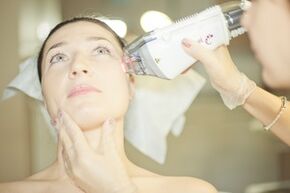
American scientists first tested the technology of fractional thermolysis in 2004. Since then, it has undergone many clinical trials and become a powerful tool in modern cosmetology. The essence of fractional thermolysis (photothermolysis, nanoperforation, fraxel) is that a special device is used to separate the laser beam into many ultrafine fractions.
The procedure involves the use of very small, targeted laser beams, which results in microscopic damage to the treated area of skin.
Laser radiation increases the local temperature of certain areas of the skin, which inevitably results in heating of the intracellular contents and destruction of cellular structures. In turn, this activates recovery processes, leading to increased production of fibrillar protein (collagen) and the formation of new epithelial cells. And the more collagen in the epidermal layer, the less wrinkles and other skin imperfections.
Given the molecular changes, it is necessary to note here the appearance of heat shock proteins, hyaluronic acid and the appearance of transforming growth factor (special polypeptide). All these substances accelerate the utilization of damaged collagen from cells and form its new molecules.
The surface layer of the skin is usually restored on the second day after cosmetic manipulations. Peeling of dead cells ends in about 10 to 12 days.
Intense recovery begins in each damaged area, because nature ensures a high rate of skin tissue regeneration. Thanks to the point effect, a fairly solid supply of healthy cells is created in the skin, which serve as a source of new epithelial cells.
Ablative and non-ablative technology
When a laser pulse is used to evaporate an active substance, it is most likely laser ablation. In ablative photothermolysis, laser radiation is used, the energy of which is mainly accumulated by water molecules. By acting briefly on the local area, the laser current instantly raises the temperature of the water contained in the tissues to 300 degrees. An open wound of small size appears at the site of evaporation, next to which thermally coagulated epithelial cells are concentrated.
Such thermolysis requires a longer recovery time than non-ablative technology, but the result will look much more spectacular. Disadvantages of the method, perhaps, can be attributed only to the fact that there is a certain risk of infection of the tissues of the deep dermal layer.
Non-ablative thermolysis is considered a less traumatic procedure. A laser beam is used here, which practically reduces the risk of damaging the epidermis to zero - a burn occurs below it. Destroyed epithelial cells do not evaporate, but settle inside the dermis, so the patient does not have to have open wounds. Tightening and rejuvenation are not as obvious as with the other method, because dead skin cells do not disappear anywhere, which means that the tightening effect is minimal.
Unlike the ablation technique, the patient is insured against skin tissue infection, because the integrity of the surface layer of the skin is not disturbed during the procedure.
Positive and negative sides
Like plastic correction, fractional thermolysis makes the skin less rough and rough. But if surgery is considered a radical way to improve the appearance of the skin, then thermolysis is called gentle. Nevertheless, its effectiveness is no less. Moreover, the range of tasks that fractional thermolysis solves is even wider than that of contour plastics.
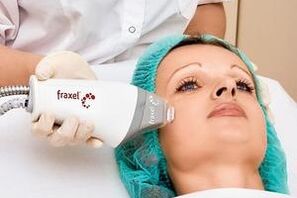
The main advantages of the technique are the following:
- recovery takes place as soon as possible;
- during the procedure the patient does not feel painful sensations;
- the result is stored for a long time;
- laser exposure is equally harmless to any skin type;
- even the most sensitive areas of the skin respond well to the laser;
- lack of strict restrictions during the rehabilitation period;
- minimal number of possible side effects;
- the risk of blood poisoning by any virus (HIV, hepatitis) is zero.
Although thermolysis is considered a high-tech and safe method, it still has its side effects, especially:
- penetration of microbial agents through the skin - staphylococci and streptococci;
- abnormal redness of the skin;
- inflammation and accumulation of fluid in the treated area of skin;
- occurrence of hyperpigmentation, minor burns and cracks, acne.
Indications and contraindications
The majority of clients are older women who want to straighten wrinkles and remove moderate wrinkles on the face and neck. Of course, the effect will meet all expectations, but, in addition, the procedure allows you to solve other cosmetic problems, including:
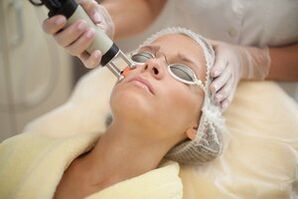
- removal of pigmentation, age spots and traces caused by the influence of sunlight;
- smoothing out the age signs of skin aging;
- smoothing deep wrinkles;
- pore narrowing;
- removal of small wrinkles on the eyelids;
- return of lost elasticity to the epidermis;
- removing the effects of acne;
- resolving stretch marks and scars.
In some circumstances, patients are forced to look for an alternative to fractional thermolysis, because laser rejuvenation can lead to completely opposite results. Thus, the procedure is contraindicated in the following cases:
- while carrying a child;
- during the lactation period;
- with exacerbation of existing diseases;
- with acute respiratory infection, including influenza;
- in the presence of malignant neoplasms;
- if the patient coagulates blood poorly;
- when the face is covered with many moles;
- if there are foci of inflammation on the skin;
- in the presence of autoimmune diseases;
- if the patient is being treated with certain medications.
Process technology
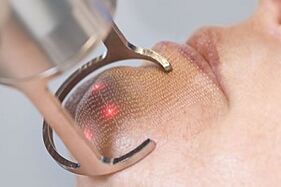
Preliminary consultation with a cosmetologist is a mandatory phase of any cosmetic procedure, in which the goal of the doctor is to clarify the client's wishes and inform about the various nuances.
First of all, the cosmetologist treats the patient's skin with a cotton pad on which an anesthetic cream is applied. Ointment is then applied to the surface of the skin to facilitate sliding of the device.
After that, armed with a device with a special extension, the specialist switches to treating problem areas. The applied anesthetic and the flow of cooled air minimize the sensation of pain, creating additional comfort for the patient. Patients, with rare exceptions, may complain of slight tingling.
The Fraxel device, developed by American scientists, has caused success in the field of non-invasive cosmetology. Specialists were given a unique opportunity to perform laser thermolysis using a specific nozzle for each specific purpose. In some preparations only thulium bar is included, while in others, erbium bar, there are also combined models. Depending on which area of skin needs to be treated, one or the other core is selected.
The whole session rarely lasts longer than thirty minutes. If you need to remove stretch marks on your hips and abdomen, this may take a little longer.
The original Fraxel device has 4 main modes of operation, each of which allows the laser beam to penetrate to a given depth:
- Good. Gentle surface treatment. Ideal for working with eyelids, breasts and other sensitive parts of the body.
- Repair. The thulium rod ensures deep penetration of the laser beam into the skin, which allows the removal of deep wrinkles and traces and the regulation of skin oil. If there is vascular dyschromia, gaping pores, such restoration is the best choice.
- Give it back. The most popular technique today that allows you to forget about shallow wrinkles and small scars after acne.
- Return dual. The procedure is performed with the simultaneous use of two rods at once - erbium and thulium. It will help those who have pronounced scars and scars.
How many sessions are needed to achieve a tangible effect largely depends on the severity of the lesions and the specifics of the treated areas, but usually at least 5-7 procedures are performed.
Characteristics of the rehabilitation period
After fractional thermolysis, the skin needs special care, especially in the early days. Restoring the masks will not be superfluous. The face should be constantly lubricated with a nourishing and moisturizing cream.

In order to achieve the achieved effect, it is extremely important to follow the simple advice of a doctor:
- the first three days exclude any physical activity;
- do not visit the bath and sauna, nor hot baths for a month;
- refuse cosmetic procedures for a month, including peeling;
- limit time spent in the sun, as excessive ultraviolet radiation is doubly dangerous for newly renewed skin;
- during recovery, give up alcohol and cigarettes.
After the procedure, some patients notice swelling and redness on the skin. It should not be scary, after a few days, as soon as the redness disappears, you need to visit a cosmetologist so he can assess the outcome of the therapy.
Edition price
Laser correction, however, is not a cheap procedure. The price of fractional thermolysis varies depending on the prestige of the clinic, the volume of work performed, the prices of consumables, etc. Thermolysis of the face and neck will cost less than the same manipulations on the abdomen, buttocks and other parts of the body.
Modern cosmetology is not standing still, but disputes about the usefulness of the use of lasers in this area have not subsided so far. Whoever says something - fractional laser thermolysis is rightly recognized as one of the safest and most effective procedures.














